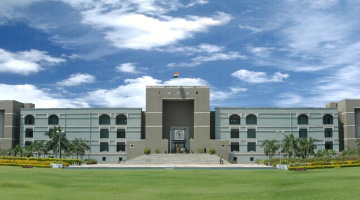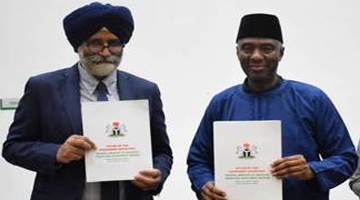CX - Petitioner's challenge to vires of s.4A of CEA, 1944 fails: High Court
By TIOL News Service
AHMEDABAD, OCT 30, 2017: THE petitioner, a manufacturer of patent or proprietary medicaments, has challenged the vires of section 4A of the CEA, 1944 [Valuation of excisable goods with reference to retail sale price] on the ground that the said provision is beyond the legislative competence of Union Legislature.
They have also challenged an order-in-original dated 21.05.2007.
Facts: By Notfn. 2/2005-CX(NT) dated 07.01.2005, PP Medicaments came to be notified for the purpose of section 4A of the Act.
The petitioner contends that the retail sale price or the MRP is not the price at which the manufacturer sells to his first purchaser; that there is always a chain of dealers before the product is ultimately sold to the consumer, each dealer adding his small profit which goes into deciding the final or retail sale price;that such retail sale price would also have to take into account multiple costs incurred after clearance of the goods by the manufacturer such as, the advertisement cost, transport cost, storage and damage, insurance etc. besides the State taxes; that by charging duty of excise on such valuation, the statutory provision breaches the basic principle of charging excise duty on manufacturing costs and manufacturing profit and partakes the character of sales tax which is not within the purview of the Union legislature.
The second challenge is with respect to the stand of the department in charging excise duty under section 4A of the Act on the ‘trade discount' provided by the petitioners in the shape of free medicines on bulk purchases. The case of the petitioners is that they have a practice of providing free of cost medicines of certain specified quantity if the purchase by the dealer exceeds certain quantity; For example, if the dealer purchases 100 boxes of specified medicine, the petitioner would charge the agreed price on such medicines and would provide, may be, 10 boxes of the same medicine without cost; that providing such free medicine is in the nature of ‘trade discount' and is vastly different from providing free or doctors' samples; that u/s 4 regime, value of such trade discounts were not includible in the assessable value.
The department, however, issued a SCN for recovery of CE duty on the ground that such free goods also carried MRP printed on the boxes and the same would ultimately be sold to the consumers at the retail price.
The demand was confirmed by the lower authorities and in appeal, the CESTAT tagged the appeal along with appeals of other manufacturers, which matter was referred to the Larger Bench, and finally the appeal was dismissed. This order is also challenged before the High Court.
The petitioner's third challenge is with respect to the levy of duty u/s 4A of the CEA, 1944 on the free samples provided to the doctors. It is submitted that such samples are provided to the doctors free of charge and do not carry any MRP and are not meant for sale in the market and, therefore, the duty cannot be levied u/s 4A.
Incidentally, during the course of arguments, the petitioners dropped the issue of non-charging of the duty under section 4A of the Act on the trade-discount provided to the dealers on the extra medicines supplied to the dealers free of cost by way of trade-discount on bulk purchases.
After considering the submissions made by both sides, the High Court in an elaborate order inter alia observed thus -
Constitutional Validity:
+ We may recall, prior to introduction of section 4A, section 4 of the Excise Act permitted levy of duty of excise on the basis of the transaction value where the sale was by the assessee to a buyer and the assessee and the buyer were not related persons and the price was the sole consideration for the sale. The term "transaction value" would include the price actually paid or payable for the goods upon sale but would also include several other charges borne by the buyer on behalf of the assessee such as, the advertising or publicity, marketing, selling, organization expenses etc. but excluding taxes applicable. We have already noted that under section 4A of the Act while substituting this basis for computation of the value for collection of excise duty in case of notified goods, the base would be the MRP but which would be reduced by the abatement that the Government may permit by issuing a notification. This abatement would take into account not only the taxes but also other charges which may not be related to the manufacturing costs, profits and other expenditure such as the advertisement, transportation and other costs.
Noting that the purpose for bringing in such legislative changes have not been brought on record, the High Court adverted to an article by Shri Daya Sagar produced before the Bench by the counsel for the Revenue and wherein an insight is provided that - previously, a similar regime was introduced for patent or proprietory medicines through a notification under which the duty was charged at 7½ % of the value calculated after allowing the discount at specified percentage. This continued to be in operation for nearly 30 years. The option was left open to the assessee to avail of such exemption notification or pay duty in terms of section 4 of the Act.
Extracting the purpose of introduction of section 4A as explained in the article and the comments of the Finance Minister in an interview mentioned therein, the High Court further observed –
“37. It can thus be seen that the modified formula for levying duty on the MRP less the abatement was provided in respect of those goods which are required to display the retail sale price under The Standards of Weights and Measures Act. The main purpose appears to be that in many of these goods, the manufacturing is entrusted to small scale manufacturers and the excise duty is leviable on the value in the hands of the job workers which would not include the element of other post-manufacturing expenses incurred by the buyer or the marketing company such as advertisement expenses, marketing expenses and other expenses like freight etc. and thus, the element of duty brought on such goods would be much less than what it would have been if the marketing company was engaged in the manufacturing activity. While doing so, the legislature consciously provided for neutralizing the element of taxes and other add ons to the MRP by authorizing the Government to provide for abatement. In the present case, the abatement notified is @ 35%. Under the circumstances, the contention of the counsel for the petitioner that the levy of duty under section 4A of the Act is outside the legislative competence of the union parliament cannot be accepted...”
In fine, the challenge to the vires of section 4A was dismissed.
Free samples:
On the question of levy of duty on free samples provided to the doctors, the High Court observed -
“…As per sub-rule (1) of Rule 96 of the Drugs and Cosmetic Rules, it is mandatory for the supplier that on such drugs intended for distribution to the doctors as free samples, the container must carry a label providing that "Physician's sample-Not to be sold". Thus, two things are firmly established. First, that the samples were provided by the petitioners free of cost to the medical professionals and that such samples are not for sale in the market…For various reasons with respect to the free samples, sub-section (2) of section 4A would not apply. The free samples provided to the doctors are not chargeable to duty with reference to value since they do not carry any value. Free samples provided to the doctors do not carry any retail sale price. … The free samples provided to the doctors on the contrary contain necessary declaration required under the law that the samples are free of charge and are not for sale in the market. The very first requirement of sub section (1) of section 4A of the Act in such a case fails. For such reasons duty of excise cannot be levied on such free samples in terms of section 4A of the Act.”
The High Court further observed -
“The fallacy of the stand of the respondents that even in such cases, the excise duty would be levied in terms of section 4A would be exposed further when we notice that even in such cases for valuation of the samples Rule 4 of the Valuation Rules of 2000 is sought to be resorted to. …, it is absolutely clear that the Valuation Rules of 2000 would apply in a case where the duty of excise is levied under section 4 of the Act. The respondents cannot seek to levy duty under section 4A but apply the method of computation of the value of the goods which is devised for the purpose of section 4 of the Act. Clarificatory instructions dated 25.04.2005 do not lay down correct position in law.”
Consequently, the petitions were disposed of with following directions -
++ The petitioner's challenge to the vires of section 4A of the Act fails.
++ It is clear that the excise duty on the doctors' free samples can be levied only under section 4 of the Act and not under section 4A.
++ Any instructions and directions to the contrary is set aside.
In passing: The High Court made it amply clear that the aforesaid declaration, by itself, would not entitle the petitioners and other similarly situated manufacturers to refund, automatically and if any applications are filed, the same would be decided in accordance with law.
(See 2017-TIOL-2270-HC-AHM-CX)














